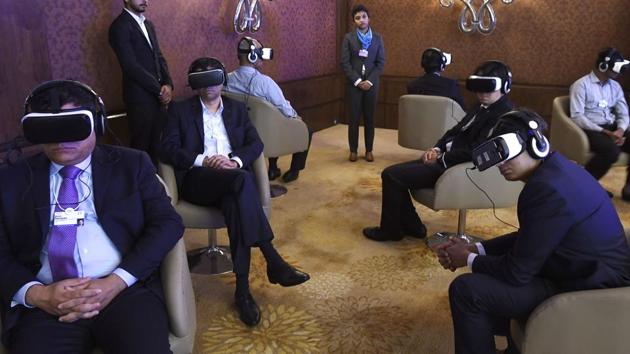The amazing possibilities of a technology-enabled future for India
Computers are doubling in their capabilities every year on a trajectory known as Moore’s Law. And everything they touch is advancing on the same exponential curve, including sensors, artificial intelligence, robotics, genomics, and energy technologies
Imagine a world in which rich and poor alike have unlimited food, live in excellent health, and can zip through the streets of Delhi, Bangalore, or Mumbai in minutes in driverless cars — and enjoy affordable clean energy, education, and comfortable housing.

This seems like a dream, doesn’t it? It isn’t. It is a future that can be created within two decades. Technology advances are literally making science fiction a reality.
Take the smartphones that even rickshawallahs can now afford. These are powered by computers many times more powerful than the Cray Supercomputers that could not be imported to India (because of an arms embargo imposed on India in the late 1980s; and this was a dual use technology). The accelerometers and gyroscopes in these are more precise than those that America’s nuclear missiles once contained. The photographs that NASA’s rover Curiosity (launched in 2011) is sending from Mars are taken with a 2 MP camera — something even the poor would scoff at now.
That is how rapidly technology is advancing. Computers are doubling in their capabilities every year on a trajectory known as Moore’s Law. And everything they touch is advancing on the same exponential curve, including sensors, artificial intelligence, robotics, genomics, and energy technologies.
India has long been held back by the cost of energy and the reliance on high-polluting fossil fuels. But the price of solar power generation has been falling by 10 to 20% a year for the past 40 years, and with every 20% reduction, total installed capacity has doubled. In 1980, solar-generated electricity in the US cost $1.50 per watt. In May, a solar power auction at Bhadla Solar Park in Rajasthan yielded a bid of Rs 2.44 per unit for a 500-megawatt installation, a greater than 99% reduction in cost. The trend is accelerating; by 2030, energy will be as inexpensive as cellphone minutes are now — and available to all.
With inexpensive energy, the problem of water shortages and waterborne viruses can be solved because boiling all of the water needed will be economical — and India is surrounded by oceans.
Along with advances in LED lighting, which are already as economical as tungsten-based lightbulbs, and breakthroughs in optimising light frequencies for growing plants, the falling price of energy makes vertical farming economical. Using sensors and artificial intelligence software to monitor crop growth in glass-enclosed buildings, India can grow all the organic food it needs.
And then there is health care. World wide, more than four billion people lack access to quality diagnostics, so ailments that could be cured if diagnosed lead instead to suffering and death. But with the declining cost of micro-electromechanical- and nanofluidic-based sensors, a new generation of inexpensive medical devices are possible.
Forus Health, for example, has developed a portable eye-screening device, called 3nethra, that can detect eye pathologies such as cataract, diabetic retinopathy, and cornea-related problems. Health Cubed has built an inexpensive medical-grade device that provides 32 measures and tests, including blood pressure, blood sugar, blood haemoglobin, and urine protein and is able to diagnose diseases such as HIV AIDS, syphilis, dengue, and malaria. MapMyGenome analyses genome data to provide insights into the genetic bases of various aspects of individuals’ health, including traits, lifestyle, drug responses, and inherited conditions. These are all Indian startups that will soon help people all over the world.
With 3D printing, within 15 years, we will be able to digitally manufacture household goods and clothing and even buildings and electronics goods. The 3D printers of today are still slow and clumsy and do little more than produce device prototypes and toys. But exponentially advancing technologies move slowly before they do amazing things.
It will also become economical to synthetically produce meat. What if you were offered cooked protein which had the appearance, texture, and taste of beef or pork but was designed on a computer and produced in a 3D printer—and no animals were even touched. Would you eat it? That is a question you may have to answer in 2027.
In education, it is already possible to watch educational videos on the same smartphones that one is gawking at Sunny Leone on. With AI-based learning apps and virtual reality headsets, which will also become affordable within five years, India’s entire education system could be transformed. Imagine learning Sanskrit by conversing with the inhabitants of ancient India, or learning mathematics by building pyramids in ancient Egypt — in virtual reality. This will be possible.
It is not going to be smooth sailing to this amazing future, though. Every technology creates new risks, disrupts industries, and destroys old-line jobs. Technologies can be used for good and for evil. The challenge for India will be to ensure that the benefits of technology are shared equally, that the rewards of each technology outweigh the risks, and that there is greater freedom and autonomy for the people. If this is done right, it could open up the era of knowledge and enlightenment that we have dreamed of.
Vivek Wadhwa is a distinguished fellow at Carnegie Mellon University in Silicon Valley.
The views expressed are personal





